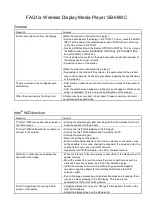
7
4.0
CONNECTING THE HARDWARE
The f irst step is to connect a video so urce to the input of the
imageMAX PLUS
and to connect its output to a display device. Below is a drawing of the unit.
Connecting the Video Inputs
The Video Scaler can accept a Composite Video, S -Video or YCbCr Component
Video input signal for scaling, as well as a computer signal input that can be
passed through.
Composite Video
- use an RCA/RCA cable to connect the Composite Video
output of the source equipment to the connector labeled “VIDEO” on the back of
the unit.
S-Video
- use an S-Video cable to connect the S-Video output of the source
video equipment to the connector labeled “S-VIDEO” on the back of the unit. S-
Video provides improved performance over Composite Video and is
recommended whenever possible.
Component Video
- use a 3RCA/3RCA cable to connect the YCbCr Component
output of the source video equipment to the 3 connectors labeled “Y, Cb, Cr” on
the back of the unit. Component Video provides the better performance than
Composite Video or S-Video and is recommended whenever possible.
PC Video
- connect the source computer’s VGA output signal to the HD15
connector labeled “PC IN” on the back of the unit.
Note – This PC Input Signal is
not scaled, but is available for pass-through when the PC Source is selected.
This input may also be used for a YPbPr input.
Connecting the Video Output
Connect th e
imageMAX PLUS’
output to the destination display device, such as
an LCD computer monitor, video projector, HDTV Set or other device, via the
HD15 connector on the back labeled “OUTPUT”.
Note:
The output signal format can be selected as either PC (RGB) or HDTV
(YPbPr) and will be covered later in this manual. When PC is selected, use the
HD-15 to HD-15 cable supplied to connect to the display device. When HDTV is
selected, use the HD-15 to 3-RCA cable supplied to connect to the display.































